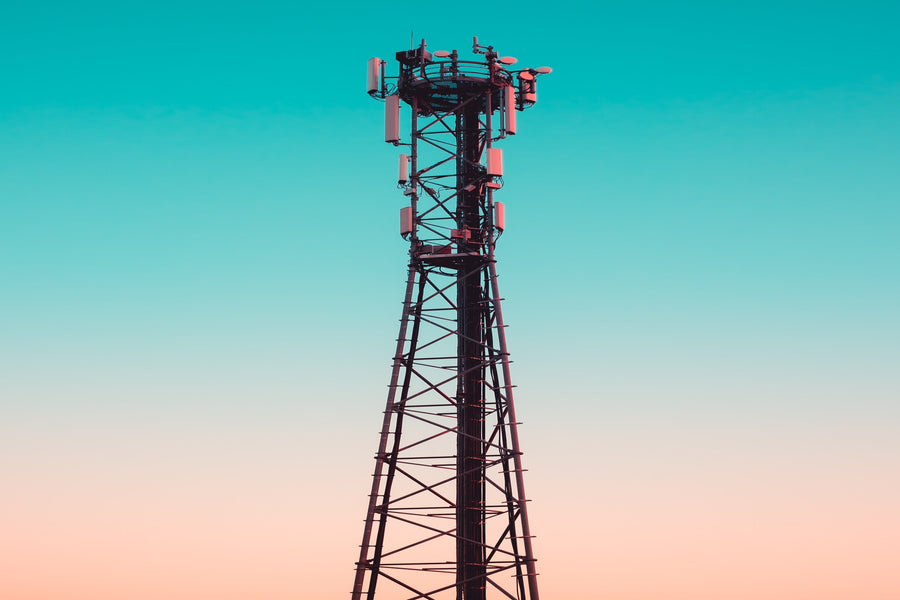Is There Any Evidence that 5G is Harmful to Health?

In the second of our four-part 5G mini-series, we're asking: is there any evidence that 5G is harmful to health?
The Full 5G Update: Part 2
This is where things start to get really interesting.
If we are to believe the world’s telecoms giants - and indeed many respected organisations and governing bodies like Public Health England - then we have nothing to fear from 5G: with ‘a lack of clear evidence’ to say that 5G poses any risk to health. But scratch a little deeper under the surface, and the answer becomes less straightforward.
‘A lack of clear evidence’ is simply not the same thing as ‘proven to be safe’, or ‘ready to roll out across the globe’.
As Danish lawyer Christian Jensen argues in his legal opinion (1) on whether establishing the 5G system would be in contravention of our human rights: “if it has on one occasion defensibly been scientifically proven that there is a damaging effect or risk of damage, then the fact that ten other defensible trials did not show such an effect or risk is irrelevant […] since the latter group does not in itself exclude the possibility that there exist real damages or risks”.
The EU Scientific Committee on Health, Environmental and Emerging Risks (SCHEER) seemed to agree with this sentiment when, in their 2018 ‘statement on emerging health and environmental issues’, (2) they said: “the expansion of broadband with shorter wavelength radiofrequency radiation highlights the concern that health and safety issues remain unknown […] The lack of clear evidence to inform the development of exposure guidelines to 5G technology leaves open the possibility of unintended biological consequences”.
"The lack of clear evidence to inform the development of exposure guidelines to 5G technology leaves open the possibility of unintended biological consequences”
In addition to this, Lloyds London - one of the world’s foremost insurance groups, certainly seemed to understand the distinction between ‘a lack of clear evidence’ and ‘proven to be safe’ well enough to conclude that they are not willing, under any circumstances, to offer health insurance cover for claims connected with wireless EMF technologies.
Way back in 2010, Lloyds London’s Risk Assessment Team released a report (3) which even went so far as to compare EMFs with asbestos, saying: “asbestos was a ‘wonder fibre’ when it was first discovered […] but when it emerged in the 1980s that asbestos caused lung diseases, claims for bodily injury started being made, and class action suits were brought in the US. The predicted cost of asbestos to the insurance industry is still rising. […] The comparison here with EMF is obvious – if it is proven to cause cancer, then the injuries may not become clear until many years after the exposure due to similarly long latency periods”.
It’s not only insurance firms who are caught up in the controversy surrounding the safety of wireless technology, either. By auctioning off frequency bands to telecoms companies, who will then use those bands to generate billions in profit, which is then taxed, governments stand to make massive financial gains from the roll out of 5G.
Big Industry vs. the public: A conflict of interest?
Could it be that a conflict of interest between Big Industry, politicians and the health of ordinary members of the public – one that involves unimaginably huge sums of money and political power – is partly to blame for the fact that ‘no sufficient evidence’ has been cited to warrant the slow-down of the 5G network roll out?
Biologist Alfonso Balmori joined the many scientists pondering this premise when he said: (4) “controversy is frequent when the scientists recognize serious effects on health and on the environment that cause high economic losses”.
Speaking to The Royal Gazette, (5) Canadian toxicology researcher Dr Heroux alleged that the telecoms industry claims there is no clear evidence of a risk to health from 5G, because they just aren’t looking for it.
“They have stock holders who are not interested in the overall picture” he said. “They do not want to explore the health impacts of their products; they want to expand. From their point of view, they will always deny it. They use very simple science to convince the public not to believe that the impacts exist”.
Whilst the potential for ‘unintended biological consequences’ remains, campaigners and independent scientists are concerned that the 5G roll out amounts to little more than a public health experiment, and are fighting for further research in order to prove its safety.
One 2019 parliamentary petition (6) calling for an independent enquiry into the health and safety risks of 5G collected more than 32,000 signatures.
Dr. Martin Pall, Professor of Biochemistry and Basic Medical Sciences at Washington State University, summed up the fears behind such petitions when he said in a recent report (7) that: “putting in tens of millions of 5G antennae without a single biological test of safety has got to be the stupidest idea anyone has had in the history of the world”.
What do we know about the impact that EMFs can have on our bodies?
What we do know for sure, is that exposure to electromagnetic fields (EMFs) of the kind emitted by 3G and 4G technologies and devices, has been found by a huge number of independent, non-industry funded scientists and doctors to be harmful to health, with scientific research documenting damage caused by EMFs since at least (8) 1966.
Last year, Dominique Belpomme, Professor of Oncology at the University Paris-Descartes, claimed that (9) “six thousand scientific articles have been published worldwide demonstrating the toxicity of electromagnetic radiation”, going on to state that “there is irrefutable evidence of the effects of electromagnetic radiation on the human body, plants and animals, as demonstrated by studies around the world”.
“six thousand scientific articles have been published worldwide demonstrating the toxicity of electromagnetic radiation”
With papers numbering in the thousands, the extent of scientific research (10) into the health impacts of EMF radiation exposure is simply too extensive to list, but a cohesive body of scientific evidence exists surrounding the damage caused to DNA, (11) cells, (12) organ systems, (13) fertility, (14) brain function, (15) liver (16) and memory, (17) to name but a few.
Does electromagnetic radiation cause cancer?
In 2011, the International Agency for Research on Cancer (IARC) classified electromagnetic radiation as a ‘possible human carcinogen’. (18)
A later scientific review (19) published in November 2018 concluded that, according to the IARC’s own criteria, there is now enough evidence to move electromagnetic radiation up the ladder from ‘possible carcinogen’ to actually ‘carcinogenic to humans’, based on a series of scientific studies conducted since the IARC’s initial 2011 categorization.
In May 2018, Dr. Martin Pall established that,(20) since 1978, a minimum of 35 scientific studies have shown EMF radiation to be carcinogenic.
"Since 1978, a minimum of 35 scientific studies have shown EMF radiation to be carcinogenic"
That number grew when in November 2018, after a 10-year-long, $30 million study, (21) the National Toxicology Program (NTP) released a final report concluding that there is clear, undeniable evidence that male rats exposed to RF radiation, like that emitted by wireless technology, developed cancerous tumours.
Governing bodies were quick to point (22) out that, “though interesting”, cancer found in rats cannot be compared to cancer found in humans.
However, some scientists say (23) that the rats’ tumours were of the same type that researchers have found to be increased in humans who have demonstrated at least 10 years of heavy mobile phone use.
Whilst Public Health England felt that the NTP studies “do not alter the balance of evidence in relation to human exposure when using mobile phone technologies”, they conceded that the results “highlight the continuing uncertainties in this complex area”.
Batting the responsibility back to the public, PHE said the studies “reinforce the importance of mobile phone users following the long-standing precautionary advice, which is available at the following links: http://www.nhs.uk/Conditions/Mobile-phone-safety/Pages/Introduction.aspx”.
Helpful then that when you go to click on the suggested link to find this advice, you are met with a blank screen and the words ‘Page not Found’.
Just last month, Turin’s Court of Appeals confirmed a 2017 decision (24) that a former Telecom Italia worker’s brain tumour was caused by his mobile phone use. That’s not merely ‘linked to’, but ‘caused by’.
"Turin’s Court of Appeals confirmed a 2017 decision that a former Telecom Italia worker’s brain tumour was caused by his mobile phone use"
This case is not a one-off either, marking the sixth time that an Italian court has affirmed a causal link between brain tumours and mobile phone use, including decisions by the High Court of Italy.
Next up in our four-part 5G series: Is 5G bad for the environment? We examine how electromagnetic radiation affects animals, birds and insects.
References
(1) https://www.emfsa.co.za/wp-content/uploads/2019/07/LegalOpinionOn5G.pdf
(2) https://ec.europa.eu/health/sites/health/files/scientific_committees/scheer/docs/scheer_s_002.pdf
(3) https://www.lloyds.com/~/media/lloyds/reports/emerging-risk-reports/emf-final-november-2010.pdf
(4) https://www.researchgate.net/publication/228379175_Possible_Effects_of_Electromagnetic_Fields_from_Phone_Masts_on_a_Population_of_White_Stork_Ciconia_ciconia
(5) http://www.royalgazette.com/business/article/20191212/researcher-warns-5g-may-be-bad-for-health
(6) https://petition.parliament.uk/petitions/233707
(7) https://www.emfacts.com/2018/08/martin-palls-book-on-5g-is-available-online/
(8) https://www.emfsa.co.za/wp-content/uploads/2019/07/LegalOpinionOn5G.pdf
(9) https://www.emfsa.co.za/news/tablets-pcs-and-mobile-phones-change-our-brains-interview-with-professor-dominique-belpomme/
(10) https://ehtrust.org/scientific-research-on-5g-and-health/
(11) https://www.ncbi.nlm.nih.gov/pubmed/28777669
(12) https://www.ncbi.nlm.nih.gov/pmc/articles/PMC5509895/
(13) https://www.cellphonetaskforce.org/wp-content/uploads/2018/06/Zory-Glasers-index.pdf
(14) https://www.ncbi.nlm.nih.gov/pubmed/27601711
(15) https://www.researchgate.net/publication/287406625_Electromagnetic_field_and_brain_development
(16) https://pdfs.semanticscholar.org/55c3/98d9788482e724017987f15eeeea72f5d24a.pdf
(17) https://www.ncbi.nlm.nih.gov/pmc/articles/PMC2666459/
(18) https://www.iarc.fr/wp-content/uploads/2018/07/pr208_E.pdf
(19) https://www.ncbi.nlm.nih.gov/pubmed/30196934
(20) https://peaceinspace.blogs.com/files/5g-emf-hazards--dr-martin-l.-pall--eu-emf2018-6-11us3.pdf
(21) https://www.niehs.nih.gov/news/newsroom/releases/2018/november1/index.cfm
(22) https://petition.parliament.uk/petitions/233707
(23) https://www.ncbi.nlm.nih.gov/pmc/articles/PMC6254861/
(24) https://childrenshealthdefense.org/news/six-italian-courts-have-ruled-that-cell-phones-cause-brain-tumors/































